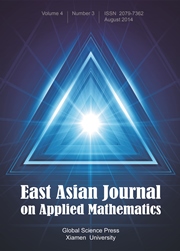Article contents
A Time Splitting Space Spectral Element Method for the Cahn-Hilliard Equation
Published online by Cambridge University Press: 28 May 2015
Abstract
We propose and analyse a class of fully discrete schemes for the Cahn-Hilliard equation with Neumann boundary conditions. The schemes combine large-time step splitting methods in time and spectral element methods in space. We are particularly interested in analysing a class of methods that split the original Cahn-Hilliard equation into lower order equations. These lower order equations are simpler and less computationally expensive to treat. For the first-order splitting scheme, the stability and convergence properties are investigated based on an energy method. It is proven that both semi-discrete and fully discrete solutions satisfy the energy dissipation and mass conservation properties hidden in the associated continuous problem. A rigorous error estimate, together with numerical confirmation, is provided. Although not yet rigorously proven, higher-order schemes are also constructed and tested by a series of numerical examples. Finally, the proposed schemes are applied to the phase field simulation in a complex domain, and some interesting simulation results are obtained.
Information
- Type
- Research Article
- Information
- Copyright
- Copyright © Global-Science Press 2013
References
- 7
- Cited by

